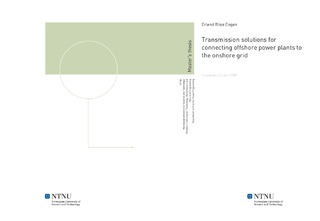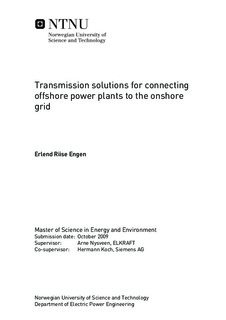| dc.contributor.advisor | Nysveen, Arne | nb_NO |
| dc.contributor.advisor | Koch, Hermann | nb_NO |
| dc.contributor.author | Engen, Erlend Riise | nb_NO |
| dc.date.accessioned | 2014-12-19T13:51:29Z | |
| dc.date.available | 2014-12-19T13:51:29Z | |
| dc.date.created | 2010-09-04 | nb_NO |
| dc.date.issued | 2009 | nb_NO |
| dc.identifier | 348925 | nb_NO |
| dc.identifier | ntnudaim:4767 | nb_NO |
| dc.identifier.uri | http://hdl.handle.net/11250/256663 | |
| dc.description.abstract | The European Union has set a binding target saying 20 per cent of their energy consumption shall come from renewable energy sources within 2020. Around 4 per cent of the total amount is planned to come from offshore installations (40 GW). There total amount of planned offshore wind capacity is as of today 37 GW, mainly installations in the North Sea. The technologies that will be used for transporting the power to the shore are either HVAC technology using XLPE cables, transistor or thyristor based HVDC systems or HVAC Gas Insulated Line (GIL) technology. However, as the different technical solutions all have advantages and disadvantages compared to the other, the size of the power plants, distances from the shore and closeness to other wind parks will decide what technology will be used for the different cases. | nb_NO |
| dc.language | eng | nb_NO |
| dc.publisher | Institutt for elkraftteknikk | nb_NO |
| dc.subject | ntnudaim | no_NO |
| dc.subject | SIE5 energi og miljø | no_NO |
| dc.subject | Elektrisk energiteknikk | no_NO |
| dc.title | Transmission solutions for connecting offshore power plants to the onshore grid | nb_NO |
| dc.type | Master thesis | nb_NO |
| dc.source.pagenumber | 44 | nb_NO |
| dc.contributor.department | Norges teknisk-naturvitenskapelige universitet, Fakultet for informasjonsteknologi, matematikk og elektroteknikk, Institutt for elkraftteknikk | nb_NO |

